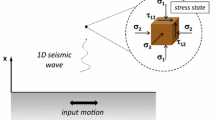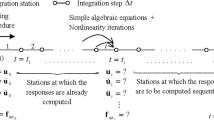Abstract
Three-dimensional numerical simulation of large model under seismic loading is a time-consuming process due to the huge number of degrees and the duration of time. With respect to the uniform time stepping method, an automatic time stepping strategy is proposed based on a finite element–finite difference coupled scheme and an effective mixed error estimation of the solid–fluid mixture. Two seismic liquefaction examples are conducted, one is a three-dimensional embankment located in liquefied area, and the other is a three-dimensional caisson wharf subjected to the seismic load. The results show that the liquefaction induces large displacement to the embankment and caisson wharf; the proposed automatic time stepping method can save 17–24 % computational time than the uniform time stepping method at the premises of similar accuracy.












Similar content being viewed by others
References
Akai K, Tamura T (1978) Numerical analysis of multi-dimensional consolidation accompanied with elastic–plastic constitutive equation. Paper presented at the proceedings of Japan society of civil engineers, pp 95–104
Di Y, Yang J, Sato T (2007) An operator-split ALE model for large deformation analysis of geomaterials. Int J Numer Anal Methods 31:1375–1399. doi:10.1002/Nag.601
Huang Y, Yu M (2013) Review of soil liquefaction characteristics during major earthquakes of the twenty-first century. Nat Hazards 65:2375–2384. doi:10.1007/s11069-012-0433-9
Huang Y, Yashima A, Sawada K, Zhang F (2008) Numerical assessment of the seismic response of an earth embankment on liquefiable soils. Bull Eng Geol Env 67:31–39. doi:10.1007/s10064-007-0097-y
Hulbert GM, Jang I (1995) Automatic time step control algorithms for structural dynamics. Comput Methods Appl Mech Eng 126:155–178. doi:10.1016/0045-7825(95)00791-X
Jackson CR (2012) Simple automatic time-stepping for improved simulation of groundwater hydrographs. Ground Water 50:736–745. doi:10.1111/j.1745-6584.2011.00898.x
Oka F, Yashima A, Kato M, Sekiguchi K (1992) A constitutive model for sand based on the non-linear kinematic hardening rule and its application. Paper presented at the proceedings of 10th WCEE
Oka F, Yashima A, Shibata T, Kato M, Uzuoka R (1994) FEM–FDM coupled liquefaction analysis of a porous soil using an elasto-plastic model. Appl Sci Res 52:209–245. doi:10.1007/bf00853951
Oka F, Yashima A, Tateishi A, Taguchi Y, Yamashita S (1999) A cyclic elasto-plastic constitutive model for sand considering a plastic-strain dependence of the shear modulus. Geotechnique 49:661–680
Shibata T, Sato T, Uzuoka R, Oka F, Yashima A, Kato M (1991) FEM–FDM coupled liquefaction analysis of a fluid-saturated ground. Paper presented at the 7th international conference on computer methods and advances in geomechanics 2, pp 869–874
Sloan SW, Abbo AJ (1999a) Biot consolidation analysis with automatic time stepping and error control part 1: theory and implementation. Int J Numer Anal Methods 23:467–492. doi:10.1002/(Sici)1096-9853(199905)23:6<467:Aid-Nag949>3.0.Co;2-R
Sloan SW, Abbo AJ (1999b) Biot consolidation analysis with automatic time stepping and error control part 2: applications. Int J Numer Anal Methods 23:493–529. doi:10.1002/(Sici)1096-9853(199905)23:6<493:Aid-Nag950>3.0.Co;2-P
Smith IM (1997) Parallel computation of large 3-D problems in geomechanics. Paper presented at the 9th international conference on computer methods and advances in geomechanics, Wuhan, China 1, pp 251–258
Tang X, Sato T (2005) H-adaptivity applied to liquefiable soil in nonlinear analysis of soil–pile interaction. Soil Dyn Earthq Eng 25:689–699. doi:10.1016/j.soildyn.2004.11.014
Tang X, Shao Q (2013) Numerical simulation on seismic liquefaction by adaptive mesh refinement due to two recovered fields in error estimation. Soil Dyn Earthq Eng 49:109–121. doi:10.1016/j.soildyn.2013.02.003
Tang GP, Alshawabkeh AN, Mayes MA (2008) Automatic time stepping with global error control for groundwater flow models. J Hydrol Eng 13:803–810. doi:10.1061/(Asce)1084-0699(2008)13:9(803)
Wang MW, Xu P, Li J, Zhao KY (2014) A novel set pair analysis method based on variable weights for liquefaction evaluation. Nat Hazards 70:1527–1534. doi:10.1007/s11069-013-0887-4
Xue XH, Yang XG (2013) Application of the adaptive neuro-fuzzy inference system for prediction of soil liquefaction. Nat Hazards 67:901–917. doi:10.1007/s11069-013-0615-0
Yimsiri S, Soga K (2010) DEM analysis of soil fabric effects on behaviour of sand. Geotechnique 60:483–495. doi:10.1680/geot.2010.60.6.483
Youd TL et al (2001) Liquefaction resistance of soils: summary report from the 1996 NCEER and 1998 NCEER/NSF workshops on evaluation of liquefaction resistance of soils. J Geotech Geoenviron 127:817–833. doi:10.1061/(asce)1090-0241(2001)127:10(817)
Zeng LF, Wiberg NE, Li XD (1992) A posteriori local error estimation and adaptive time-stepping for newmark integration in dynamic analysis. Earthq Eng Struc 21:555–571. doi:10.1002/eqe.4290210701
Zhang YL, Feng XT, Yang CX, Li SJ (2001) Parallel computing methods in geotechnical engineering. Paper presented at the frontiers of rock mechanics and sustainable development in the 21st century, Beijing, China, pp 365–368
Zienkiewicz OC, Xie YM (1991) A simple error estimator and adaptive time stepping procedure for dynamic analysis. Earthq Eng Struc 20:871–887. doi:10.1002/eqe.4290200907
Acknowledgments
This research was supported by the National Basic Research Program of China (973 Program) Granted No. 2011CB013605-2 and the National Natural Sciences Foundation of China Granted No. 51079062. The authors are gratefully appreciated. The authors would also like to thank the reviewers for their thorough reviews and useful suggestions.
Author information
Authors and Affiliations
Corresponding author
Rights and permissions
About this article
Cite this article
Zhang, X., Tang, X. & Uzuoka, R. Numerical simulation of 3D liquefaction disasters using an automatic time stepping method. Nat Hazards 77, 1275–1287 (2015). https://doi.org/10.1007/s11069-015-1651-8
Received:
Accepted:
Published:
Issue Date:
DOI: https://doi.org/10.1007/s11069-015-1651-8




